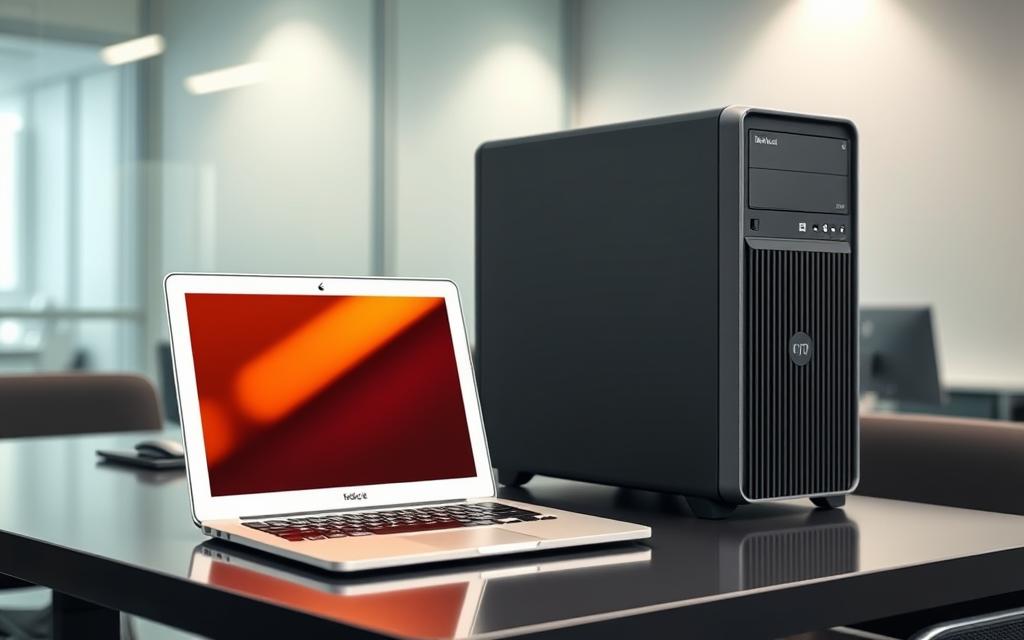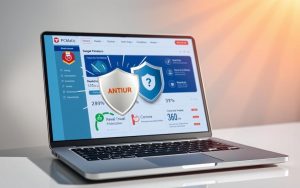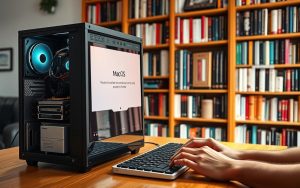Table of Contents
The debate between these two computing systems has shaped corporate decisions for decades. Since the 1984 Macintosh launch, companies have weighed innovation against compatibility when selecting workstations.
Early adoption trends reveal stark contrasts. IBM dominated 66% of the corporate market in 1983, while Apple struggled at 9%. Yet the graphical interface revolution changed how users interact with technology permanently.
Modern enterprises face critical choices. Research shows poor technology decisions can cost firms hundreds of thousands in productivity losses and ownership expenses. Security features, hardware costs, and workforce adaptability all demand careful evaluation.
This guide examines performance metrics, security benchmarks, and total cost analyses from leading industry reports. We’ll provide actionable insights to help your organization make informed investments in workplace technology.
Introduction: Understanding the Mac vs PC Debate
Businesses today face a critical decision when selecting their primary workstations. The choice between Apple’s hardware with macOS and multi-brand devices running Windows or Linux shapes productivity and efficiency. Over the years, the debate has moved beyond stereotypes, focusing on practical needs and technical distinctions.
Globally, over 2 billion users rely on PCs, while Apple devices serve around 100 million. These numbers reflect diverse preferences across industries. Traditionally, Apple products were associated with creative fields, but today, 19 industries integrate them into their workflows. This shift highlights their growing versatility.
IBM’s 2022 report revealed significant cost savings with Apple devices, ranging from $273 to $543 monthly. These findings challenge the perception that Apple solutions are less economical. Companies now consider blended approaches, using different systems for creative departments and IT teams. This strategy optimizes performance and cost-efficiency.
Understanding the hardware and design differences is crucial. Apple’s ecosystem offers seamless integration, while PCs provide broader customization options. The operating system choice also impacts user experience and software compatibility. Evaluating these factors helps businesses make informed decisions tailored to their needs.
Cost Comparison: Is Mac or PC Better for Business Budgets?
Budget considerations play a pivotal role in selecting workplace devices. Companies must evaluate both upfront and long-term expenses to make informed decisions. This section breaks down the financial aspects to help you understand the total cost of ownership for each option.

Upfront Costs
Entry-level devices offer a starting point for budget-conscious businesses. A MacBook Air begins at $599, while a Dell XPS starts at $400. For high-end needs, the Mac Pro costs $6,999, compared to a PC workstation at $5,000. These differences highlight the price range available for various business needs.
Long-Term Ownership Costs
Hidden expenses can significantly impact budgets. AppleCare+ provides extended support, while PCs often rely on in-house maintenance. Resale values also differ, with Macs retaining 35% of their value after five years, compared to PCs at 15%. IBM’s 2022 study found that Macs have an 18-22% lower total cost of ownership over four years.
| Device | Entry-Level Price | High-End Price | Resale Value (5 Years) |
|---|---|---|---|
| Mac | $599 | $6,999 | 35% |
| PC | $400 | $5,000 | 15% |
Budget flexibility is another factor. PCs offer DIY options for customization, while Macs provide standardized builds. This distinction allows companies to choose based on their specific financial and operational needs.
Performance and User Experience
When evaluating workplace technology, performance and user experience are critical factors. These elements determine how efficiently teams can complete tasks and how satisfied employees are with their tools. Both systems offer unique advantages, but understanding their differences helps businesses make informed decisions.
Hardware and Software Integration
Apple’s vertical integration ensures that hardware and software work seamlessly together. This approach enhances stability and reduces compatibility issues. For example, the M2 Ultra chip delivers exceptional speed for creative professionals, with 78% of designers preferring Apple devices.
On the other hand, PCs offer a modular approach, allowing businesses to customize components. This flexibility is ideal for IT teams that need specific configurations. Tools like JAMF for Apple devices and PDQ Deploy for PCs simplify enterprise management, ensuring smooth operations.
User Interface and Ease of Use
The user experience varies significantly between systems. Apple’s macOS is known for its intuitive design, making it easy for employees to adapt quickly. In contrast, Windows provides extensive customization options, catering to diverse workflows.
However, PCs often come with bloatware, averaging 23 preinstalled apps. This can slow down performance and frustrate users. Apple’s zero-touch provisioning streamlines enterprise deployment, reducing setup time and improving efficiency.
- Benchmark tests show the M2 Ultra outperforms Intel Core i9 in real-world tasks.
- Video editors report smoother workflows on Apple devices, while data analysts prefer PCs for their versatility.
- Enterprise feedback highlights that Apple devices last 5-8 years, offering long-term value.
Security: Mac vs PC for Business Safety
Ensuring robust protection against digital risks is a top priority for modern enterprises. The choice between systems significantly impacts how effectively companies can safeguard their data and operations. This section explores key aspects of security, including malware threats, update frequency, and vulnerability management.
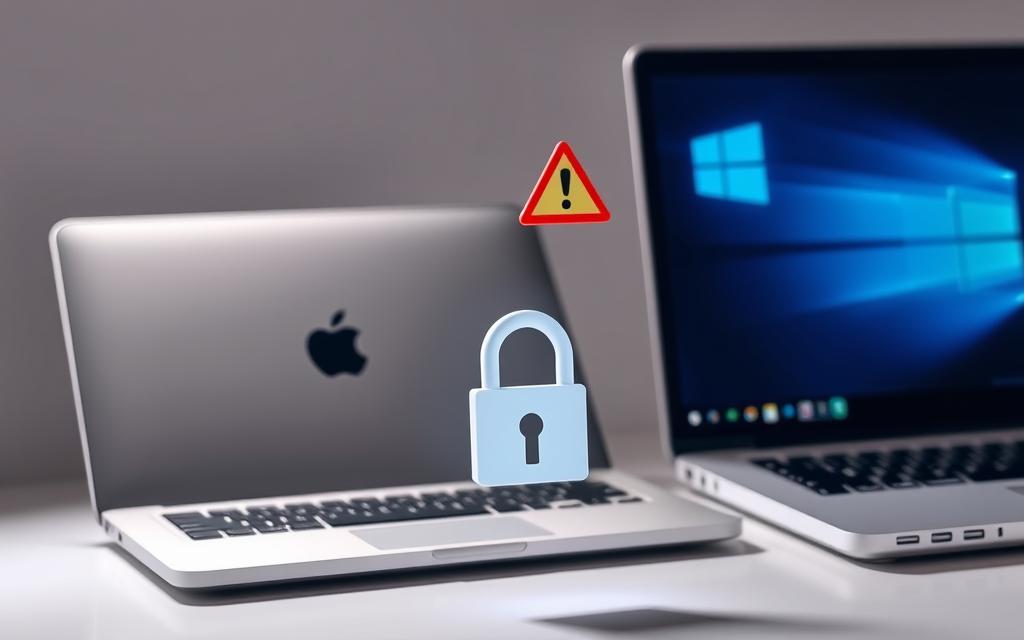
Malware and Cyber Threats
Malware remains a persistent challenge for businesses. Recent data shows that 87% of attacks target Windows systems, compared to just 9% for macOS. This disparity highlights the importance of understanding platform-specific risks.
Ransomware incidents, such as the 2023 healthcare network breach, demonstrate the devastating impact of cyber threats. Windows systems were compromised in 72% of cases, while Apple devices remained unaffected due to their closed ecosystem.
Update Frequency and Vulnerability Management
Timely updates are critical for maintaining security. Apple’s silent updates are deployed 72 hours faster than Windows patches, which often require system reboots. This efficiency minimizes downtime and reduces exposure to vulnerabilities.
Windows 10 has tracked 357 critical CVEs, emphasizing the need for proactive patch management. In contrast, Apple’s XProtect tool offers real-time malware detection, providing an additional layer of defense.
| System | Malware Attacks | Update Speed | Critical Vulnerabilities |
|---|---|---|---|
| Mac | 9% | 72 hours faster | Low |
| PC | 87% | Standard | 357 CVEs |
Enterprise security tools also play a vital role. XProtect and Windows Defender offer robust protection, but the annual cost for PC security averages $2,300 per user. Apple’s integrated solutions provide a cost-effective alternative without compromising safety.
Compatibility and Customization
The ability to integrate seamlessly with existing systems often determines the success of workplace technology. Businesses must evaluate how well devices align with their current infrastructure and workflows. This section explores key aspects of compatibility and customization, helping you make informed decisions.
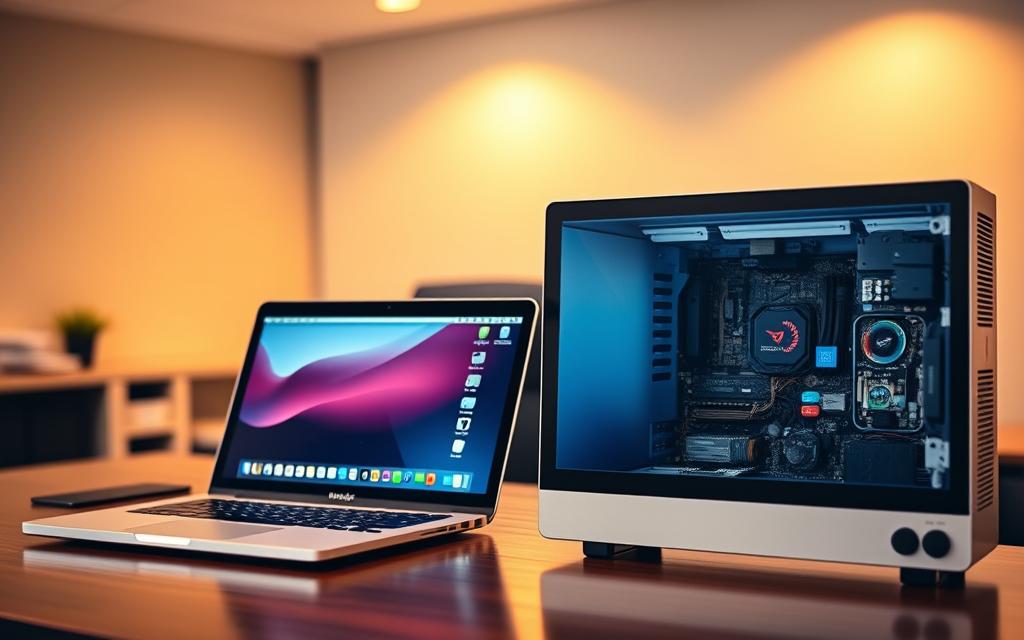
Software and Hardware Compatibility
Cross-platform software availability is crucial for businesses. Research shows that 92% of enterprise applications are accessible on both major operating systems. However, file format limitations, such as .DMG files on Windows, can pose challenges.
Industry-specific tools also play a significant role. For example, AutoCAD benchmarks reveal a 15% performance boost on Windows compared to macOS. Legacy systems like SAP and Mainframe often require specific configurations, making compatibility a critical factor.
Customization Options
Custom builds offer flexibility for businesses with unique needs. A financial firm’s trading PC, for instance, requires high-speed processors and multiple monitors. PCs excel in this area, allowing tailored configurations to meet specific demands.
Peripheral support is another consideration. Thunderbolt 4 adoption rates are higher on Apple devices, but PCs offer broader options for external hardware. Tools like Boot Camp and Parallels enable macOS users to run Windows applications, though performance varies.
| Aspect | Mac | PC |
|---|---|---|
| File Format Support | .DMG limitations | Broad compatibility |
| Enterprise Software Access | 92% cross-platform | 92% cross-platform |
| Custom Build Options | Limited | Extensive |
Understanding these factors helps businesses choose the right technology. Whether prioritizing compatibility or customization, each system offers distinct advantages tailored to specific needs.
Conclusion: Making the Right Choice for Your Business
Selecting the right technology for your organization requires careful evaluation of specific needs and long-term goals. Many businesses now adopt blended solutions, with 43% using both systems to optimize performance and cost-efficiency. This approach minimizes transition challenges, which can cause an 18% productivity dip during OS switches.
Effective management tools like SimpleMDM and Microsoft Intune simplify deployment and maintenance. A detailed cost of ownership analysis reveals significant savings over time, making it easier to justify your choice.
Consider your industry’s unique demands when selecting devices. Small firms may prioritize affordability, while enterprises often focus on scalability and security. A well-planned transition roadmap ensures minimal disruption and maximum ROI.
Explore free trials for MDM solutions to test their compatibility with your workflow. The right choice today can drive long-term success for your organization.
FAQ
Which operating system offers better cost efficiency for businesses?
Windows-based PCs generally have lower upfront costs, while Macs may provide better long-term value due to durability and optimized performance.
How do Macs and PCs compare in terms of security for business use?
Apple’s macOS has historically faced fewer malware attacks, but Windows has improved significantly with frequent updates and enterprise-grade security tools.
Can businesses easily integrate Macs into existing Windows environments?
Yes, with proper IT support, Macs can work alongside Windows machines using cross-platform software and cloud-based solutions.
Which platform provides better hardware and software integration?
Apple’s ecosystem offers seamless integration between Macs and other Apple devices, while Windows PCs provide broader compatibility with third-party hardware.
Are Windows PCs more customizable than Macs for business needs?
Yes, PCs offer greater flexibility in hardware upgrades and component replacements compared to Apple’s more closed system.
How does the user experience differ between Mac and PC for business applications?
Macs are known for intuitive design and stability, while Windows PCs offer wider software support and familiar interfaces for most corporate environments.
Which platform receives more frequent security updates?
Both Apple and Microsoft provide regular updates, with Windows typically pushing patches more frequently for enterprise customers.
Can businesses save money by choosing PCs over Macs?
Initial hardware costs are typically lower for PCs, though total cost of ownership depends on software needs, maintenance, and employee productivity factors.


